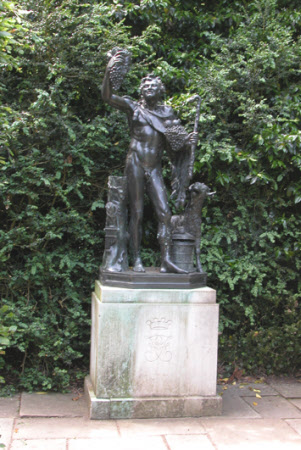Faun in Rosso Antico
probably Italian (Neapolitan) School
Category
Art / Sculpture
Date
1901 - 1939
Materials
Bronze
Measurements
1910 x 820 x 640 mm
Place of origin
Naples
Order this imageCollection
Anglesey Abbey, Cambridgeshire
NT 515128
Summary
Bronze, Faun in Rosso Antico, Italian (probably Neapolitan) School, after the antique, c. 1901-39. A full-size bronze cast of the Faun in Rosso Antico, after the original 2nd century AD sculpture carved of Laconian red marble which is in the Capitoline Museum, Rome (inv.no. MC0657). The drunken faun, nude save for a nebris, a fawn skin, fastened across his proper right shoulder, holds aloft a heavy bunch of grapes and looks towards it, smiling. A long-haired goat at the faun's feet also looks up at the grapes with the same toothy grin. The goat rests its proper right foreleg on a basket full of grapes. The faun has curly hair, pointed ears and holds in his proper left hand a shepherd's crook, another bunch of grapes and pomegranates. His panpipes hang from a tree trunk at proper right. The base of the cast is inscribed 'MUNIFICINTIA/ D.N DENEDICTI PP XIV/ A.D.MDCCXLVI', an inaccurate transcription of the inscription on the original marble which should read: 'MUNIFICENTIA/ SS.D.N. BENEDICTI.PP.XIV/ A.D. M.D CCXLVI' commemorating the date, 1746, that Pope Benedict XIV gave the statue to the Capitoline Museum. Mounted on a stone pedestal engraved 'ANNVS MIRABILIS'/ 'AD MCMXLV' with the Fairhaven monogram and baronial coronet to commemorate the end of the Second World War.
Full description
The original Faun in Rosso Antico was discovered at Hadrian's Villa in 1736 and given to the Capitoline Museum by Benedict XIV ten years later. It was admired for the close-grained dark-red marble with which is was carved, rarely seen in large sculptures and never seen before in full-size statuary. For a full account see Haskell and Penny 1981, no. 39. The Anglesey cast, which bears no maker's mark, is reputed to have been purchased in Naples by Lord Fairhaven's mother Cara Rogers Broughton (1867-1939) (Roper 1964, p. 65). Naples became a centre for bronze casting after the antique in the 1860s when the National Archaeological Museum began to authorise official reproductions of its celebrated collection items. The leading maker of bronze replicas was the Fonderia Chiurazzi, established in 1870, which assembled one of the richest collections of moulds and offered casts in three patinas: Herculaneum (dark), Pompeii (green), and Rinascimento (gleaming bronze). Casts were marketed to wealthy European tourists - the Chiurazzi emporium was conveniently located opposite the National Museum - and also purchased for public display and for museums. Alice Rylance-Watson 2019
Provenance
Brought from Naples by Cara Rogers Broughton (1867-1939) and originally in her garden at Park Close, Englefield Green; bequeathed to the National Trust by Huttleston Rogers Broughton, 1st Lord Fairhaven (1896-1966) with the house and the rest of the contents.
Credit line
Anglesey Abbey, The Fairhaven Collection (The National Trust)
Marks and inscriptions
Front of bronze base: MUNIFICINTIA/ D.N DENEDICTI PP XIV/ A.D.MDCCXLVI Pedestal: ANNVS MIRABILIS/ AD MCMXLV
Makers and roles
probably Italian (Neapolitan) School, sculptor
References
Haskell and Penny 1981: Francis Haskell and Nicholas Penny, Taste and the Antique, The Lure of Classical Sculpture 1500 - 1900, New Haven and London, 1981, pp. 213-5, no. 39, fig. 111. Roper 1964: Lanning Roper, The Gardens of Anglesey Abbey, Cambridgeshire. The Home of Lord Fairhaven, London 1964, p. 65, pl. 46. Christie, Manson & Woods 1971: The National Trust, Anglesey Abbey, Cambridge. Inventory: Furniture, Textiles, Porcelain, Bronzes, Sculpture and Garden Ornaments’, 1971, p. 160.
